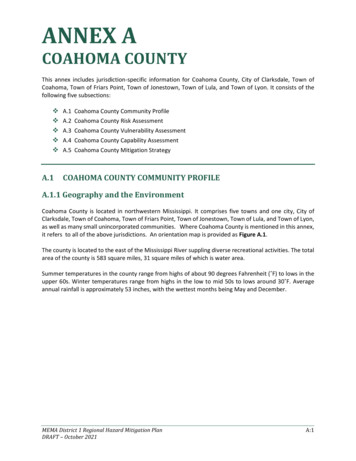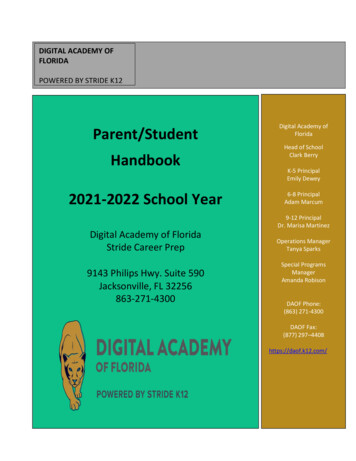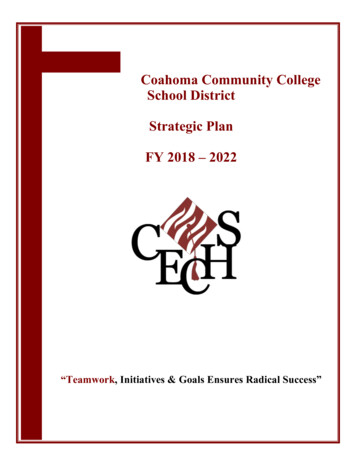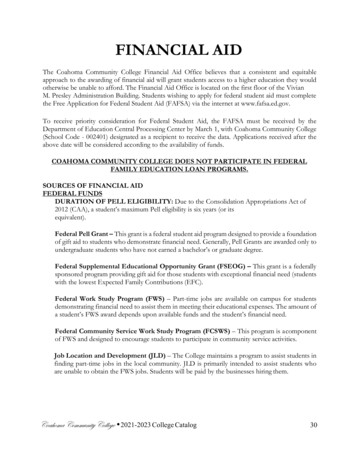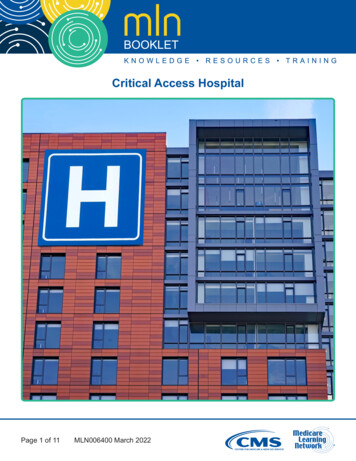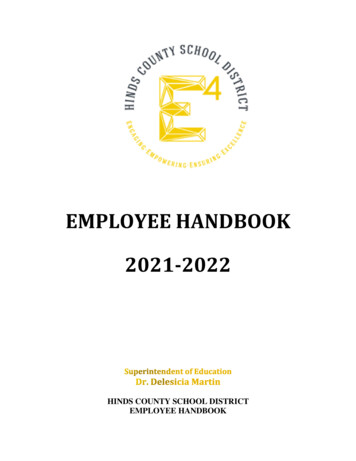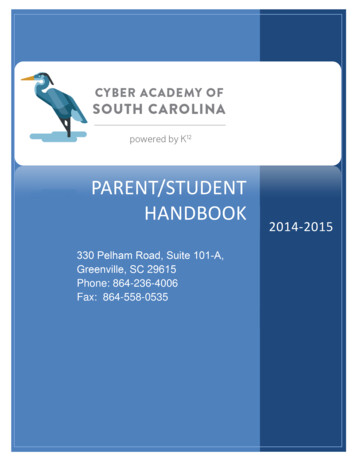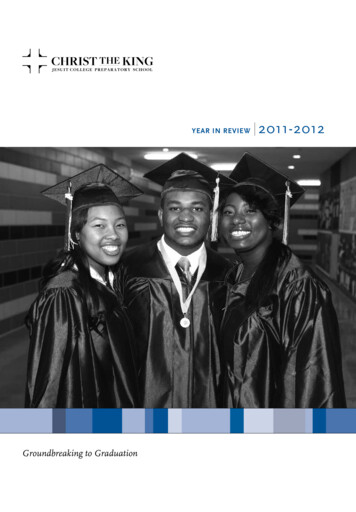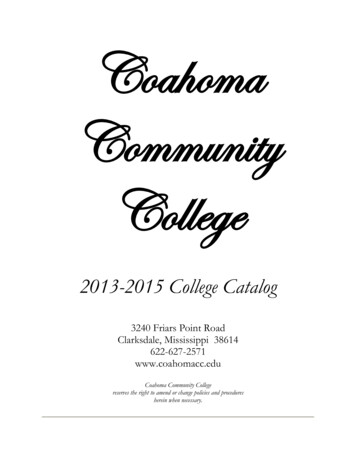
Transcription
CoahomaCommunityCollege2013-2015 College Catalog3240 Friars Point RoadClarksdale, Mississippi 38614622-627-2571www.coahomacc.eduCoahoma Community Collegereserves the right to amend or change policies and proceduresherein when necessary.
ACCREDITATIONCoahoma Community College is accredited by the Commission on Colleges of the SouthernAssociation of Colleges and Schools to award the Associate of Arts degree, the Associate of AppliedScience degree, and certificates in career education. Contact the Commission on Colleges at 1866Southern Lane, Decatur, Georgia 30033-4097 or call 404-679-4500 for questions about theaccreditation of Coahoma Community College.ACCREDITATION OFHEALTH SCIENCE PROGRAMSThe Associate Degree Nursing Program is accredited by the Mississippi Board of Trustees of StateInstitutions of Higher Learning, 3825 Ridgewood Road, Jackson, Mississippi 39211,Phone Number: 601-432-6493. The Associate Degree Nursing Program has Candidate Status withtheAccreditation Commission for Education in Nursing Inc., formerly the National League forNursing Accreditation Commission, Inc., 2243 Peachtree Road, Suite 850, Atlanta, Georgia, 30326,Phone Number: 404-975-5000.The Practical Nursing Program is accredited by the Mississippi Community College Board, 3825Ridgewood Road, Jackson, Mississippi 39211, Phone Number: 601432-6518.The Polysomnographic Technology Associate Degree Program is accredited by the Commission onAllied Health Education Programs (CAAHEP),1361 Park Street, Clearwater, Florida, 33756, phonenumber (727) 210-2350, fax number (727)210-2356, www.caahep.org.The Associate Degree Paramedic Program at Coahoma Community College currently holds a“Letter of Review” awarded by the Committee on the Accreditation of Educational Programs forthe EMS Professions (CoAEMSP), a division of the Commission on Accreditation of Allied HealthEducation Programs (CAAHEP). Under this “LoR”, the Paramedic Program is recognized asmaking satisfactory progress towards becoming accredited and is therefore approved to graduate students whoare then qualified to sit for the NREMT exam for paramedic. CoAEMSP 8301 Lakeview Pkwy.Suite 111-312 Rowlett, TX 75088 Phone: (214) 703-84452Coahoma Community College 2013-2015 College Catalog
The Respiratory Therapy program at Coahoma Community College holds Provisional Accreditationfrom the Commission on Accreditation for Respiratory Care (www. coarc.com). This status signifiesthat a program that has been granted an Approval of Intent has demonstrated sufficient complianceto initiate a program in accordance with the Standards through the completion and submission of anacceptable Self Study Report (SSR), and other documentation required by the CoArc Board. Theconferral of Provisional Accreditation denotes a new program that has made significant progresstowards meeting the Standards of Accreditation. The program will remain on ProvisionalAccreditation until achieving Initial Accreditation. It is recognized by the National Board forRespiratory Care (NBRC) toward eligibility to the Respiratory Care Credentialing Examination(s).Enrolled students completing the program under Provisional Accreditation are considered graduatesof a CoArc accredited program.Commission on Accreditation for Respiratory Care1248 Harwood RoadBedfore, Texas 76021-4244(817) 283-28835MEMBERSHIPThe American Association of Community and Junior CollegesMississippi Association of CollegesThe Mississippi Community/Junior College AssociationCoahoma Community College 2013-2015 College Catalog3
TABLE OF CONTENTSACADEMIC CALENDAR. 5GENERAL INFORMATION . 7COLLEGE ADMISSIONS . 18STUDENT EXPENSES . 29FINANCIAL AID . 32SCHOLARSHIPS . 40ENROLLMENT AND SCHEDULING . 47INSTRUCTIONAL POLICIES . 51STUDENT RECORDS POLICIES . 56GRADUATION POLICIES . 62ACADEMIC SERVICES . 64STUDENT AFFAIRS AND SUPPORT SERVICES . 68WORKFORCE DEVELOPMENT . 82PROGRAMS OF STUDYUNIVERSITY PARALLEL DEGREE PROGRAMS OF STUDY . 85CAREER AND TECHNICAL DEGREE/CERTIFICATEPROGRAMS OF STUDY. 142HEALTH SCIENCE PROGRAMS OF STUDY. 175COURSE DESCRIPTIONSACADEMIC COURSE DESCRIPTIONS .184CAREER AND TECHNICAL COURSE DESCRIPTIONS .195HEALTH SCIENCE COURSE DESCRIPTIONS .216COLLEGE ADMINISTRATORS AND FACULTY. 2244Coahoma Community College 2013-2015 College Catalog
ACADEMIC CALENDARFall 2013August 5MondayFaculty Return / Professional Development ConferenceAugust 6TuesdayFaculty Work DayAugust 7WednesdayDormitories OpenAugust 7-9Wednesday- Friday RegistrationAugust 12MondayDay and Evening Classes Begin / Late Registration BeginsAugust 23FridayMSVCC (online) Registration EndsAugust 23FridayLast Day to Register for Day and Evening ClassesAugust 26MondayMSVCC (online) Classes BeginAugust 26-27Monday-TuesdayMSVCC (online) Drop/AddSeptember 2MondayLabor Day HolidaySeptember 3TuesdayClasses ResumeOctober 2-4Wednesday-FridayMidterm ExaminationsOctober 18FridayLast Day to Drop a Class without Receiving a Grade and toremoveIncomplete “I” from Previous SemesterNovember 5TuesdayReservation for Spring MSVCC (Online) ClassesNovember 5TuesdayEarly Registration for Spring 2014 BeginsNovember 8FridayLast Day to Withdraw MSVCC (online)November 25-29 Monday- FridayThanksgiving HolidaysDecember 2MondayClasses ResumeDecember 2MondayLast Day to Officially Withdraw from the Institution Receiving a“W” gradeDecember 2-5Monday-ThursdayFinal Examinations for Evening StudentsDecember 4-6Wednesday-FridayFinal Examinations for Day StudentsDecember 9MondayFinal Grades Due in the Admissions and Records Office by4:00 PMDecember 9MondayOnline Grades Due (MSVCC)December 10TuesdayChristmas Holidays Begin for Faculty and StudentsCoahoma Community College 2013-2015 College Catalog5
Spring 2014January 2ThursdayFaculty / Personnel ReturnJanuary 2ThursdayDormitories OpenJanuary 2-3Thursday - FridayRegistrationJanuary 6MondayDay and Evening Classes Begin / Late Registration BeginsJanuary 10FridayMSVCC (online) Registration EndsJanuary 13MondayMSVCC (online) Classes BeginJanuary 13-14Monday-TuesdayMSVCC (online) Drop/AddJanuary 17FridayLast Day to Register for Day and Evening ClassesJanuary 20MondayMartin Luther King Jr. HolidayJanuary 21TuesdayClasses ResumeMarch 5-7Wednesday-FridayMidterm ExaminationsMarch 10-14Monday-FridaySpring BreakMarch 17MondayClasses ResumeMarch 21FridayLast Day to Drop a Class Without Receiving a Grade andto remove Incomplete “I” grades from the Fall 2013 SemesterMarch 28FridayLast Day to Withdraw from MSVCC (online) ClassesApril 1TuesdayRegistration for Fall and Summer MSVCC (Online) ClassesBeginsApril 17ThursdayLast Day to Officially Withdraw from the Institution Receiving a“W” GradeApril 18FridayGood Friday HolidayApril 21MondayEaster HolidayApril 21MondayEvening Classes Resume at 5 PMApril 22TuesdayDay Classes ResumeApril 28MondayFinal Grades due for MSVCC (Online) ClassesMay 5-7Mon-WednesdayFinal ExaminationsMay 7WednesdayGrades Due by 4:00PM in the Registrar’s OfficeMay 10SaturdayGraduation and Commencement Exercises at 10:00 AMMay 10SaturdayLast Day for 9-Month Academic Faculty6Coahoma Community College 2013-2015 College Catalog
GENERAL INFORMATIONMISSION STATEMENTCoahoma Community College, located in the northwest corner of the rural Mississippi Delta, is anaccredited, public, comprehensive, two-year institution of higher learning dedicated to serving Bolivar,Coahoma, Quitman, Tallahatchie, and Tunica counties and beyond. Serving as a catalyst for economicand community development, Coahoma Community College provides accessible, affordable, diverse,and quality educational opportunities and services that foster a nurturing teaching and learningenvironment, promotes intellectual and work readiness skills, supports personal and professional growth,and prepares students to enter the job market or transfer to a college or university.COAHOMA COMMUNITY COLLEGE GOALS1. Provide academic transfer programs that parallel with the first two years of college/universityprograms.2. Provide career and technical education programs that prepare students to enter the job market ortransfer to a college or university.3. Meet the needs of area businesses and industries by providing workforce training programs.4. Empower students with the necessary tools to maximize their potential by providing a networkof support services and activities.5. Utilize emerging instructional technology by providing innovative learning opportunities forstudents.6. Address community and economic development needs within the service area by developing andsustaining partnerships with public and private agencies.7. Initiate new programs or complement existing programs by securing and sustaining federal, state,and local funding.8. Support cultural enrichment programs and activities.9. Ensure institutional effectiveness by planning, assessing, and evaluating all activities andprograms.Coahoma Community College 2013-2015 College Catalog7
COAHOMA COMMUNITY COLLEGEBOARD OF TRUSTEESMr. Johnny McGlown, PresidentMr. Donald Clark, Vice PresidentMrs. Pauline Rhodes, SecretaryMs. Rena Butler, Asst. SecretaryMr. William Bradley, Legal AdvisorMr. Willie BlockerMr. Bernard Stephen ChandlerMr. Ned GathwrightRev. Andrew HawkinsRev. Dennis HawkinsMrs. Brenda J. HopsonMr. Robert G. MasonMs. Eddie McCordAttorney Cynthia MitchellMr. David WilliamsBOARD OF SUPERVISORSCOAHOMA COMMUNITY COLLEGE DISTRICTCOAHOMA COUNTYBOLIVAR COUNTYJohnny NewsonTimothy BurrelChris OvertonPaul PearsonRoger WienerEddie Andrew Williams, IIILarry KingPreston BillingsJames McBrideDonny WhittenQUITMAN COUNTYTALLAHATCHIE COUNTYBrooks EarnestSheridan BoydJessie EllisManuel KillebrewBobby TurnerLarry ColesMarcus EcholsJohnny GoodwinKenneth HavensCary HayesTUNICA COUNTYRev. McKinley DaleyHenry Nickson, Jr.Cedric Burnette8James DunnPhillis V. WilliamsCoahoma Community College 2013-2015 College Catalog
Non-Discrimination StatementCoahoma Community College is an equal opportunity institution in accordance with civil rights anddoes not discriminate on the basis of race, color, national origin, sex, disability, age, or other factorsprohibited by law in any of its educational programs, activities and employment opportunities. Thefollowing person has been designated to handle inquiries regarding the non-discrimination policies:Wanda G. Holmes, Director of Human Resources/Coordinator for 504/ADA, Title IX ComplianceOfficer, Office #A100, Vivian M. Presley Administration Building, 3240 Friars Point Road,Clarksdale, Mississippi 38614, Phone: (662)621-4853, Email: wholmes@coahomacc.edu.Accommodations for Students with Disabilities and Related LawsCoahoma Community College is committed to ensuring equal access to an education for enrolled oradmitted students who have verified disabilities under Section 504 of the Rehabilitation Act of 1973and the Americans with Disabilities Act of 1990 (ADA). College policy calls for reasonableaccommodations to be made for eligible students with verified disabilities on an individual andflexible basis.Any student enrolling in Coahoma Community College with a documented disability, who requestsaccommodations, must first provide a current evaluation of the disability from a medicalprofessional. This documentation, which is required by federal guidelines, will remain on file in theoffice of the ADA/Section 504/Title IX Coordinator.Section 504 of the Rehabilitation Act of 1973 obligates the College, as a recipient of federalfinancial assistance, to assure that qualified persons with disabilities are not excluded from programsand services on the basis of their disability.The Americans with Disabilities Act of 1990, which covers all public entities and "places ofpublic accommodation," reinforces this obligation, including the requirement to make reasonableaccommodations in policies and practices to accommodate the limitations of individuals withdisabilities. Services or benefits may not be provided to individuals with disabilities throughprograms that are separate or different unless the separate programs are necessary to ensure equallyeffective benefits and services.The Americans with Disabilities Act of 2008 revises the definition of "disability" to more broadlyencompass impairments that substantially limit a major life activity. The amended language alsostates that mitigating measures, including assistive devices, auxiliary aids, accommodations, medicaltherapies and supplies (other than eyeglasses and contact lenses) have no bearing in determiningwhether a disability qualifies under the law. Changes also clarify coverage of impairments that areepisodic or in remission that substantially limit a major life activity when active, such as epilepsy orpost-traumatic stress disorder. The amendments took effect January 1, 2009.Coahoma Community College 2013-2015 College Catalog9
HISTORY OF COAHOMA COMMUNITY COLLEGECoahoma County Agricultural High School was established in 1924 becoming the first agriculturalhigh school in Mississippi for Negroes under the existing "separate but equal" doctrine. The juniorcollege curriculum was added in 1949, and the name of the institution was changed to CoahomaJunior College and Agricultural High School.During the first two years (1949-1950), the junior college program was conducted by one full-timecollege director/teacher and a sufficient number of part-time teachers from the high school division.A full-time dean and college faculty were employed in the third year of operation.During the first year of operation (1949), Coahoma Junior College was supported entirely by countyfunds. In 1950, Coahoma Junior College became the first educational institution for Negroes to beincluded in Mississippi's system of public junior colleges and to be eligible to share in fundsappropriated by the Mississippi Legislature for the support of public junior colleges. Other countiesalso began to support the junior college, including Bolivar, Quitman and Sunflower.In 1965, Coahoma Junior College opened its doors to all students regardless of race, color, sex,national origin, or disability.During its history, Coahoma Community College and Agricultural High School has been headed byeight superintendents and four presidents: M. L. Strange, 1924-25; J. M. Mosley, 1924-29; J. W.Addison, 1929-37; J. B. Wright, 1937-45; B. F. McLaurin, 1945-66; J. E. Miller, 1966-79; McKinleyC. Martin, 1980-92; and the incumbent Vivian M. Presley, 1992 to June 2013. With her appointmentas superintendent/president on January 6, 1992, Dr. Vivian Presley became the first female to headCoahoma Community College and Agricultural High School and the first woman to head acommunity/junior college in the state of Mississippi. Dr. Valmadge Towner was named CoahomaCommunity College’s fifth president to join an esteemed group of college leaders, July 2013.With the approval of the Board of Trustees of Coahoma Junior College and the State Board forCommunity and Junior Colleges, Coahoma Junior College's name was changed to CoahomaCommunity College, effective July 1, 1989.In the spring of 1995, after many years of not having an official district, a bill was introduced to andpassed by the Mississippi Legislature and signed by the Governor Kirk Fordice giving CoahomaCommunity College a district. Effective July 1, 1995, the Coahoma Community College districtbecame Bolivar, Coahoma, Quitman, Tallahatchie, and Tunica Counties.10Coahoma Community College 2013-2015 College Catalog
OFFICE OF INSTITUTIONAL EFFECTIVENESSThe purpose of the Office of Institutional Effectiveness is to provide Coahoma CommunityCollege's decision makers with accurate and useful research, assessment and planning services, andaccreditation compliance activities that support the College's mission and improve the quality andeffectiveness of Coahoma Community College. The Office of Institutional Effectiveness isresponsible for providing leadership and oversight to the research, planning, assessment, andaccreditation activities of Coahoma Community College. This office provides leadership andoversight to these activities by:1.2.3.4.5.6.7.8.9.10.11.Organizing Strategic Planning Council Committee meetings and overseeing the review andevaluation of the institution’s mission statement and Strategic Plan;Organizing Institutional Effectiveness Planning Committee meetings and overseeing thereview and evaluation of the Institutional Effectiveness Plans for Coahoma CommunityCollege’s educational programs, administrative support programs, educational supportprograms, and community/public service programs;Organizing Program Review Committee meetings and overseeing program reviews forCoahoma Community College’s Academic, Health Services, Career-Technical,Administrative, and Educational Support Services;Organizing Substantive Change Committee meetings and overseeing the review ofinstitutional changes and the implementation of the institution’s Substantive Change Policy;Coordinating the administration of college-wide surveys including the development, analysis,and the dissemination of results;Coordinating the administration of student evaluations of instructors including thedevelopment, analysis, and the dissemination of results;Coordinating the administration of performance reviews of employees;Ensuring that compliance with accreditation requirements of the Commission on Colleges ofthe Southern Association of Colleges and Schools is incorporated into the planning andevaluation processes of the institution;Coordinating the preparation of the annual profiles and any other reports requested by theCommission on Colleges of the Southern Association of Colleges and Schools;Coordinating the preparation of annual IPEDS data as well as other data required by state,regional, and federal agencies;Developing, analyzing, and disseminating annual planning and evaluation documents to theinstitution’s decision-makers.The Office of Institutional Effectiveness is located on the second floor of Coahoma CommunityCollege’s Vivian M. Presley Administration Building.Coahoma Community College 2013-2015 College Catalog11
LOCATION OF INSTITUTIONThe main campus of Coahoma Community College is located in Coahoma County north of the cityof Clarksdale, Mississippi. Coahoma is easily accessible from four major highways: U.S. 61, U.S. 49,Miss. 6, and Miss. 1. The ninety-nine acre campus lies in an agrarian setting along Friars Point Roadnear the Mississippi River, which forms the western boundary of Coahoma County. CoahomaCommunity College provides educational services throughout its five-county service area at the offcampus locations.OFF-CAMPUS LOCATIONSCHARLESTON SITECharleston High School310 North Cossar AvenueCharleston, MS 38921CoahomaCommunityCollege DistrictMARKS SITEQuitman County Vocational Center1501 Martin Luther King DriveMarks, MS 38646MOUND BAYOU SITEJ.F. Kennedy High School204 N Edwards AvenueMound Bayou, MS 38762ROSESDALE SITEWest Bolivar High School505 N Main StreetRosedale, MS 38769TUNICA SITETunica Middle School2486 US-61 N 2110 EastTunica, MS 38676SHAW SITEShaw High School214 Dean BoulevardShaw, MS 38773WEBB SITEWest Tallahatchie High School2110 US Highway 49 EastWebb, MS 38966ALLIED HEALTH TRAINING CENTER901 Ohio StreetClarksdale, MS 3861412WORKFORCE DEVELOPMENT CENTER510 Sunbelt DriveClarksdale, MS 38614Coahoma Community College 2013-2015 College Catalog
FACILITIESThe J. W. ADDISON ADMINISTRATION BUILDING was originally constructed in 1963and enlarged in 1969. This building served as the center for the administrative activities of thecampus until 2011. It currently houses the offices of the Vice President for Academic Affairs,Educational Outreach and other administrative offices for the Division of Academic Affairs. It isnamed in honor of J. W. Addison, a former superintendent of Coahoma Agricultural High School.The ZEE A. BARRON STUDENT UNION was constructed in 1975. It is named in honor ofone of the school's former organizers, Zee A. Barron. The Student Union houses many diverseoffices and activity centers. This facility provides offices for Vice President for Student Affairs andSupport Services, the Dean of Student Affairs and Support Services, the Director of StudentActivities, Student Government Association, and the Housing Director. In addition, this facilityprovides space for a student lounge, the campus cafeteria/grill, meeting rooms (including theMagnolia Room), the faculty dining area, and the Tigers' game room.The BARRON-MILLER CENTER FOR FINE ARTS, originally constructed in 1965 as asmall gymnatorium for the high school, was named in honor of the school's first full-time musicdirector and the second president. When originally constructed, the facility was used for physicaleducation classes, small assemblies, and basketball practice. The facility was renovated in 1990-1991to be used primarily by Coahoma Community College as a facility for art classes, performing arts,and small assemblies. The two-story building houses the Henry Dorsey Studio, the Thomas A.Richardson Studio, the Georgia A. Lewis Theater, the Eddie Mae Jackson Drama Laboratory, andthe Miriam Green Writer and Artist Laboratory.The BLACKBURN ANNEX is named in honor of a former director of the Division ofVocational and Technical Education, Samuel Blackburn. This building houses the institution'smaintenance department and high school automotive mechanic shop.The ROSIE BROWN SANDY BAYOU BUILDING was originally constructed on the campusas a county elementary school and was considered part of the Coahoma Community College andAgricultural High School Complex. Because of declining enrollment, the school was closed. In 1976,the college purchased the facility to be used as a classroom building. This building was dedicated inmemory of one of its most outstanding teachers and administrators, Rosie Brown. The building iscurrently used by the college and Coahoma Agricultural High School.The CAIN VOCATIONAL BUILDING was named in honor of two dedicated instructors,Joseph and Hettie Cain. The facility houses high school building trades, and a technology classroom.The building was renovated in 1991.The COAHOMA COMMUNITY COLLEGE ALLIED HEALTH TRAINING CENTER,constructed in 2007, is a 26,000 square-feet facility that houses the Respiratory Care, the PracticalNursing, the Associate Degree in Nursing, and other short-term health care training programs. Thisbuilding is located off-campus at 901 Ohio St. Clarksdale, MS 38614.Coahoma Community College 2013-2015 College Catalog13
The COAHOMA COMMUNITY COLLEGE WORKFORCE DEVELOPMENTCENTER was originally built in 1992 and expanded in 1997. The facility is located in the CoahomaCounty Industrial Park on Highway 49. The Center houses ABE/GED, Customized Training,Industrial and Workforce Development Training, and the Coahoma County Literacy Council.The CONSUELLA CARTER MUSIC HALL, constructed in 1967, is named in honor ofConsuella Carter, a former band director and music instructor at Coahoma Community College.This building houses the Band Director’s office, a classroom, a rehearsal hall, and storage space.The CHRISTINE J. CURRY HALL was constructed in 1965 as a business building. An additionwas made in 1969. It houses the Business and Computer Information Systems Department, theHealth, Physical Education and Recreation Department, and the Testing Center. It is named inhonor of Christine J. Curry, a long-time department head of the Business Department.The DICKERSON-JOHNSON LIBRARY AND LEARNING RESOURCES CENTER isnamed in honor of the institution's first librarian, Ethel V. Dickerson, and Lillian Rogers Johnson, aformer organizer of the College. The Library occupies the second and third floors of the buildingwith the Reference Section and computer lab on the second floor and the General Collection, MainReading Room, Black Heritage Collection Media Center residing on the third floor.The LEE FLOWERS CAREER/TECHNICAL BUILDING, originally constructed in 1962, isnamed in honor of Lee Flowers, a deceased instructor in the building trades. It originally housedclassrooms, shops, and laboratories for brick masonry. After the building sustained heavy damagesfrom a tornado in 1984, it was completely renovated in 1985 to a two-story structure. The first floorcurrently houses the Barbering & Cosmetology Programs. The second floor houses Business andOffice Systems Technology and Child Care Technology Programs.The FRIENDS RESIDENCE HALL, a three-story facility, was constructed in 1983. It provideshousing for 122 male students and includes lounges, lobbies, and kitchenettes. The building wasrenovated in 2006.FRANK W. GAMBRELL, JR. STUDENT AFFAIRS MULTI-COMPLEX BUILDING,constructed in 2003, is a state of the art facility that houses Department of Safety, student healthservices, student laundry, student mail, and the Fitness and Wellness Center.IRMA GAMBRELL CHILD CARE CENTER is named in honor of Irma Gambrell, a longtime employee and loyal supporter of the college. The facility was originally constructed to housevocational programs for the high school. After the building sustained heavy damages from a tornadoin 1984, it was completely renovated in 1988 to house the Child Care Training Center. Currently, thefacility houses the Musical Choir Room and other offices.The GEORGE A. GREEN ATHLETIC FIELD HOUSE, constructed in 2002, is named inhonor and in memory of the late former football coach, George A. Green. This modern facility hastwo dressing rooms, a state-of-the-art weight room, a meeting room, three offices, a reception area,and a laundry room.14Coahoma Community College 2013-2015 College Catalog
The MARTIN CENTER FOR LIFELONG LEARNING was originally constructed in 1928.After the college was established in 1949, it was used as the college dining hall. An addition wasmade in 1969, and it was renovated in 1975 to serve as the central location for the Division ofContinuing Education. In 1987, it was named in honor of Dr. McKinley C. Martin, formerpresident/superintendent of Coahoma Community College and Agricultural High School. It housesthe offices of Project Upward Bound and Educational Talent Search.B. F. MCLAURIN VOCATIONAL-TECHNICAL CENTER, constructed in 1969, is namedin honor of the school's first president, B. F. McLaurin. This building houses facilities for HotelRestaurant Management Technology, Industrial Maintenance Technology, Residential Carpentry,Welding Technology, Culinary Arts Technology and Automotive Technology and various offices ofthe Counselors and Work-Based Learning Coordinator.SEZZIE MCLAURIN RESIDENCE HALL, constructed during the 1983-84 school year, wasnamed in honor of the deceased wife of the first president. This two-story building provides housingfor 52 female students. It also includes lounges, lobbies, and kitchenettes.JAMES E. MILLER STADIUM, constructed in 1979, is named in honor of the second president,James E. Miller. This stadium, which is home field of the Coahoma Community College Tigers, hasa seating capacity of 2,500. The James E. Miller Stadium was completely renovated during the 199798 academic school year with the addition of a new 1,678 square feet entrance building that providesspace for ticket sales, concession, and restroom facilities.The GEORGE W. MOORE RESIDENCE HALL, constructed in 2002, is a modern two-storymen's dormitory. It houses 120 students and is handicap accessible. This building was named inhonor of the late George W. Moore, a former college instructor and administrator.The PINNACLE was constructed in 1992-1993. This modern 34,474 square foot facility housesfour classrooms, several offices, athletic dressing rooms, a permanent stage area, and an arena floorarea for sporting events. The arena seats more than 4,000, houses a press box that doubles as acontrol and sound booth, and a video-taping area. The building is also used for cultural events forthe College and the community.The PRESIDENT'S HOME, constructed in 1997, is located on the south end of the campus eastof Friars Point Road. It is a beautiful one-story frame building with 4,252 square feet of living space.The VIVIAN M. PRESLEY ADMINISTRATION BUILDING was constructed in 2010 and isnamed in honor of the fourth president of the college. This modern facility provides more than24,000 square feet of space primarily for administrative offices. There are approximately 15,000 sq.ft. on the first floor which houses the Busi
Coahoma Community College 2013-2015 College Catalog 3 The Respiratory Therapy program at Coahoma Community College holds Provisional Accreditation from the Commission on Accreditation for Respiratory Care (www. coarc.com). This status signifies that a program that has been granted an Approval of Intent has demonstrated sufficient compliance
